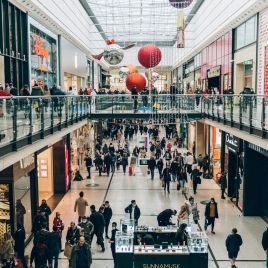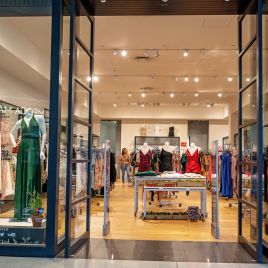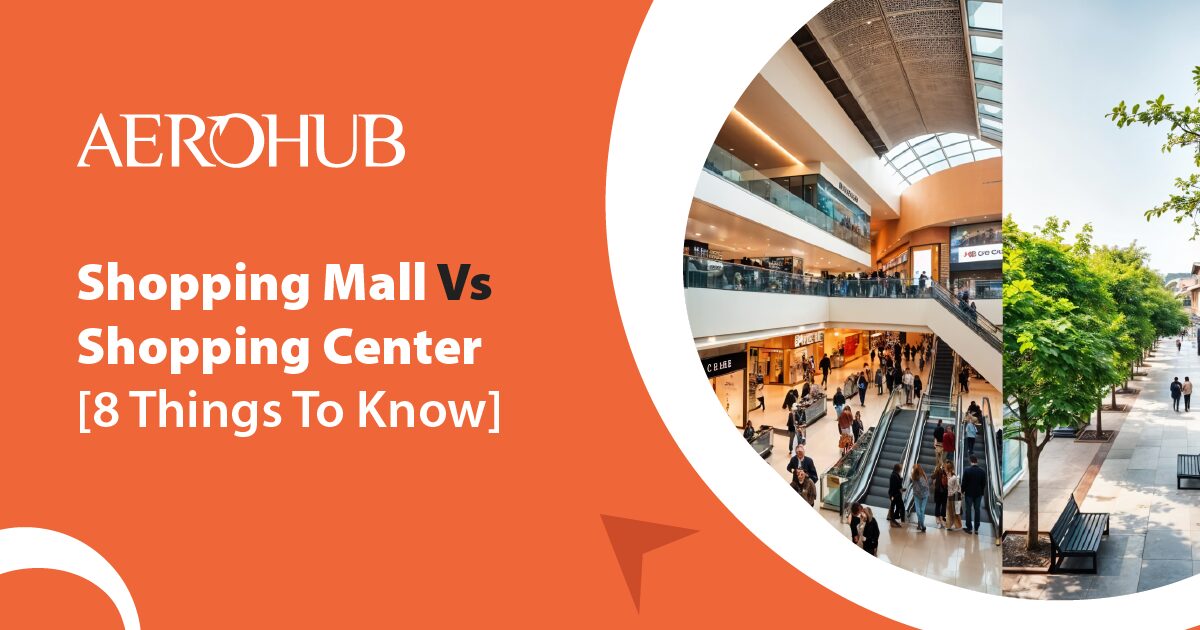Are shopping mall vs shopping center terms identical? Both of them give a sense of buying. Yet, they display different experiences and prologues to provide readers insight into the significant difference between the two favourite shopping destinations; understanding the differences and similarities between shopping malls and shopping centres is an essential general comparison between large and small shopping malls, including the sizes of the malls, the layout of the malls, plus the type of stores available and all this information may help a consumer decide where to shop.
Understanding the Difference Between Shopping Malls and Shopping Centers
‘Shopping has moved out of the conventional market centre’. These large complexes have now adopted a venue for all kinds of convenience, entertainment, and virtual type establishments for purchase. The more pertinent question is to ask: what makes these two different? Now, it is time to discuss between shopping malls vs shopping centres. Generally, malls must become places where customers can spend as much time shopping for products, having meals and being entertained. On the other hand, due to their organisational clarity, shopping centres pay more attention to providing easy access to services with more straightforward floor plans.
Know About shopping mall vs shopping center to Help Navigate the Retail Landscape
In this new millennium, malls and shopping centres are becoming more than places to buy goods; instead, they are becoming more critical social and physical hubs for residents in urban spaces. Since the shift from simple product-oriented customer purchase needs to experience economy, these shopping locations integrate entertainment, food courts and community events functions. According to a study by IBISWorld, the mall retail industry continues to grow, fueled by a demand for spaces that blend retail with leisure.
They give various choices and offer people multiple opportunities for social activity and places to eat out, watch films, and even attend an event or two, making them drivers of city life. Hence, although supermarkets are large, shopping centres have emerged as relatively small spaces but important hubs for convenience. They serve the local communities’ retail convenience stores for basic needs. However, they are gradually adding more food and services as social destinations. These spaces have emerged as critical in today’s retail store operations, where social interaction and engagement are almost as important as purchasing products.

Main Differences Between Malls and Shopping Centers
1. Size and Scale:
Malls:
Usually, it is a vast covered facility area with numerous types of shops, food outlets, and attractions. It is important to note that the malls serve the need for shopping, leisure and other related activities, and that’s why they occupy more space. For example, malls like Mall of America in the US offer an extensive selection of stores and entertainment, drawing in a large crowd
Shopping Centers:
More miniature in comparison with the stores mentioned above, shopping centres, as a rule, are specialised in some retailing. These can have only a limited number of shops and often encompass only necessary services or perhaps some small shops. For instance, a local neighbourhood shopping centre might have general merchandise stores like liquor, fruit, chemists, or retail shops.
2. Layout and Design:
Malls:
Standard mall designs exhibit numerous interconnected floor levels or floors that consist of food courts, entertainment areas and a number of retail stores. This design is intended to provide an almost continuous shopping environment where people can comfortably shop from one building without moving to another. Malls like Dubai Mall utilise vertical space for a wide array of experiences
Shopping Centers:
Malls are typically single-story or, at most, low-rise structures and, hence, have a more linear touch. In most cases, the design of a typical website is well-structured to allow fast and convenient access. These centres are small and more functional to shop in for day errands, not for a tourist-like feel or leisurely trips.

3. Ambience and Atmosphere:
Malls:
They design markets with features like zones based on specific themes and greatly scaled food courts and entertaining facilities, including multiplex theatres and gaming zones. These malls provide social interaction and are favourite rendezvous for families and young people. Their large layouts usually feature greenery in the interiors or areas which can be used for social functions. Most of the environments are lively and appealing to both shoppers and visitors.
Shopping Centers:
But then again, we have markets that are relatively more laid back and possess the feel of a community marketplace. Such centres are primarily oriented to the population’s needs, providing facilities for daily shopping. These standalone stores leave more of a customer comfort factor due to their smaller size and limited complicated floor plans where customers can quickly grab groceries or almost anything needed for their home without walking amid a large crowd of other shoppers as found in large malls.
4. Anchors:
Malls:
Big brand outlets like Lifestyle, Shoppers Stop, or Reliance Trends are identified department stores and act as traffic pullers in various malls in Chennai. These big-box stores are the prime attraction that leads to the smaller surrounding retail outlets. For instance, malls target large numbers of people drawn by such likes of Zara and H&M to the fashion and lifestyle anchor stores.
Shopping Centers:
On the other hand, eating areas can have anchor Stores like the Big Bazaar or More supermarkets where consumers can get channel retailing for everyday use. These anchors are even more localised and target consumers who may need easy, convenient access to grocery or home essentials or a small appliance. The existence of anchors, one or two, tends to give the shopping centres a more neighbourhood perspective.

5. Customer Experience:
Malls:
In Chennai, large malls like AerohubMalll best shopping mall in chennai provide much more than just shopping. They are often combined with recreational facilities, including supermarkets or departmental stores, multiplex cinemas, amusement parks, video games and fun fairs, concert and exhibition facilities, etc. Their food courts and signature restaurants thus accommodate different foods perfect for get-togethers, guaranteeing a satisfying day out.
Shopping Centers:
On the other hand, shopping centres are more about convenience to the customers. They always meet particular demands, providing a relevant shopping experience. People visit this centre for groceries, for a packet of sugar, for fence paint, and the like, and they do not come here with the expectation of being entertained or fed as the malls do. It is slightly different here – the customer gets exactly what they want, perhaps in a less sophisticated environment.
6. Location and Accessibility:
Malls:
Chennai has big branded malls centrally located; they can be anywhere. These malls are visible on critical access routes such as roads and highways and in relation to the transportation network, meaning they are easily accessible to individuals. This central location lures the retail consumers who wish to Shop while they drop–eat or attend other events.
Shopping Centers:
Virgin shopping centres- the most convenient for all residents- are customarily located in relatively affluent suburban or residential districts. Ritchie Street is one of the electrical and electronics markets for those working in IT companies. As they are located in different neighbourhoods, they come in handy when buying items within our local area, with no need to be forced to run to crowded malls.
7. Ownership and Management:
Malls:
Most of Chennai’s giant malls are owned or operated by prominent real estate firms or investors. Such companies usually have adequate capital to open a more differentiated establishment, which includes quality retail outlets, superior entertainment, and quality restaurants, thus making the mall a total complex.
Shopping Centers:
Property owners or small real estate firms would own that type of centre. Such centres are usually more locally oriented, covering certain kinds of stores, such as grocery stores or households. This ownership model enables specific management, but several malls offer considerably low establishments and entertainment features.
8. Tenant Mix:
Malls:
Malls usually accommodate many tenants that range within a given customer needspan. These include large department stores, chain specialists in fashionable clothing and accessories, electrical and household goods, supermarkets, leisure complexes, cinemas, and video game parlours. This offers a full assortment and complete shopping concept for consumers with various demands.
Shopping Centers:
In contrast, the shopping centres market is segmented into more specific niches in the retail market. They can limit themselves, for example, to numbered grocery stores, home improvement stores or shops for pets, sports, and health. These centres provide more specialised shopping requirements, convenience, and accessibility for general consumer requirements.
Aerohub: Elevating Urban Living
From our experience at Aerohub, we also believed that internet connection was part and parcel of the modern-day world. That is why our communities are designed to be close to some of the biggest shopping malls/centres in Chennai, which ensures that our residents can easily access as many types of shops as possible. Whether you are making a leisurely shopping trip, a speedy chore run or a day out for meals and movies, we remain conveniently located, so you are never far from the best the city has to offer. From fun-packed malls with entertainment sections to small Local shopping centres, Aerohub puts convenience, comfort and diverse shopping options right at your doorstep, making every ride seem easy.
Conclusion
The key to improving your shopping experience could be improving the distinction between shopping malls and shopping centres. Currently, people search for one-stop shopping with a dynamic spirit or a mall with less confusion; Chennai provides several choices. For consumers who want to spend the entire day shopping for food, clothing, and other requirements, malls are the perfect place to eat and be entertained. At the same time, centres are ideal for shoppers who want to make general, daily needs shopping trips. The positive outlook here calls on those searching for retail space to consider conventional and non-conventional spaces and find the best space that suits their needs.
FAQs: On the Decoding of Malls and Shopping Centers
Q1: In one’s opinion, what distinguishes a mall from a shopping centre?
A1: Shopper’s Marts are generally large, several-story buildings with many shops and services, including retail shops, restaurants, and so on, usually with big department stores as the major tenants. Trading centres are centralised and compact, single-story intermediaries used for a particular purpose, like selling KPO and are situated in suburban regions.
Q2: Which type of shopping destination is best for shopping?
A2: That all depends on what precisely you want. Malls are more shoppers’ destinations with diverse shops and services and leisure and entertainment areas. This makes it different from shopping centres, which are more convenient and practical and can be easily accessed quickly with specific shopping needs.
Q3: Which mall do Muslim consumers have to consider shopping at?
A3: Consider the differences between shopping for many things or a few things, pace of the shopping location, ease of access (including the location and parking) and nature of your shopping experience (entertainment, fast, or slow).
Q4: What benefits do malls and shopping centres bring to the local economy?
A4: Shopping centres and malls help employers provide work for their citizens and bring in customers worldwide. For instance, the latter attracts more pedestrians than other types of facilities, which serve individual stores and companies nearby well.
Q5: What can affect the development of the retail industry in the future?
A5: It also includes the concept of omnichannel retailing, meaning that one can buy goods both online and offline; retailing will emphasise the use of technology in creating unique shopping places, which makes the buyer interact closely with the product.


